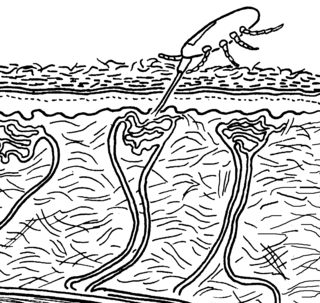Poultry diseases occur in poultry, which are domesticated birds kept for their meat, eggs or feathers. Poultry species include the chicken, turkey, duck, goose and ostrich.
Acariasis is an infestation with mites.
Hypoaspis is a genus of mites in the family Laelapidae.

Dermanyssus gallinae is a haematophagous ectoparasite of poultry. It has been implicated as a vector of several major pathogenic diseases. Despite its common names, it has a wide range of hosts including several species of wild birds and mammals, including humans, where the condition it causes is called gamasoidosis. In both size and appearance, it resembles the northern fowl mite, Ornithonyssus sylviarum.

Mesostigmata is an order of mites belonging to the Parasitiformes. They are by far the largest group of Parasitiformes, with over 8,000 species in 130 families. Mesostigmata includes parasitic as well as free-living and predatory forms. They can be recognized by the single pair of spiracles positioned laterally on the body.

Oribatida, also known as oribatid mites, moss mites or beetle mites, are an order of mites, in the "chewing Acariformes" clade Sarcoptiformes. They range in size from 0.2 to 1.4 millimetres. There are currently 12,000 species that have been identified, but researchers estimate that there may be anywhere from 60,000 to 120,000 total species. Oribatid mites are by far the most prevalent of all arthropods in forest soils, and are essential for breaking down organic detritus and distributing fungi.

Gamasoidosis, also known as dermanyssosis, is a frequently unrecognized form of dermatitis, following human infestation with avian mites of the genera Dermanyssus or Ornithonyssus. It is characterized by pruritic erythematous papules, macules and urticaria, with itching and irritation resulting from the saliva the mites secrete while feeding. These bites are commonly found around the neck and areas covered by clothing, but can be found elsewhere on the body. The avian mite Dermanyssus gallinae can also infest various body parts, including the ear canal and scalp.

Parasitus is a genus of mites in the family Parasitidae, including the following species:

Androlaelaps is a genus of mites in the family Laelapidae.
The Macronyssidae are a family of parasitic mites in the order Mesostigmata.

The Laelapidae are a family of mites in the order Mesostigmata. The family is also referred to in the literature as Laelaptidae, which may be the correct spelling.

Dermanyssidae is a family of mites in the order Mesostigmata.

Ornithonyssus sylviarum is a haematophagous ectoparasite of poultry. In both size and appearance, it resembles the red mite, Dermanyssus gallinae. They primarily infect egg laying chickens. They contribute to economic damage and feed on their host's blood which leads to lowering the egg production and feed conversion efficiency. Anemia or death can be an effect of a high amount of infestation within the birds. While they mainly do target wild birds they can also become permanent ectoparasites in the domestic poultry. The main nesting sites are generally in a close proximity to poultry coops.

Macrochelidae is a family of mites in the order Mesostigmata.

Lasioseius is a genus of mites in the family Ascidae.
Pseudoparasitus is a genus of mites in the family Laelapidae.

Rhinonyssidae is a family of mites in the order Mesostigmata. There are about 16 genera and at least 460 described species in Rhinonyssidae.

Ptilonyssus is a genus of mites in the family Rhinonyssidae. There are at least 230 described species in Ptilonyssus.
Uroactinia is a genus of mites in the order Mesostigmata, placed in its own family, Uroactinidae.

Mites are small crawling animals related to ticks and spiders. Most mites are free-living and harmless. Other mites are parasitic, and those that infest livestock animals cause many diseases that are widespread, reduce production and profit for farmers, and are expensive to control.














